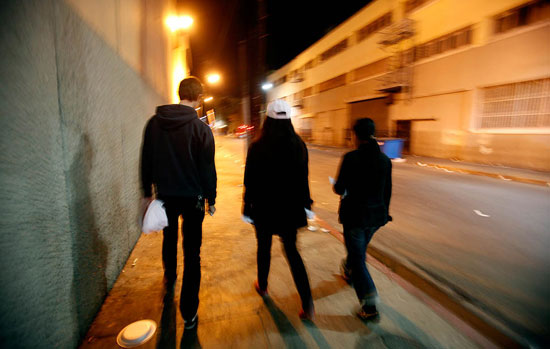Everyone should count
January 24, 2013

Homeless Count organizers are hoping for an even bigger volunteer turnout than in 2011. Photo/L.A. Times.
For Los Angeles to effectively confront the shame of homelessness, it needs a clear picture of the problem. And the 2013 Greater Los Angeles Homeless Count—the largest of its kind in the country—is preparing to undertake its most ambitious effort yet to bring the issue into sharper focus—hopefully, with your help.
“We have three thousand volunteers so far, and we’re trying to get to five thousand,” said Mark Silverbush, policy and planning analyst for the Los Angeles Homeless Services Authority, which organizes the count and coordinates regional efforts to assist the homeless. “We will have more data available than ever before.”
Silverbush said that more than 70 cities and 20 communities are joining the effort
Volunteers aged 18 and older can sign up online to participate in the count throughout L.A. County, except in the cities of Glendale, Pasadena and Long Beach, which are doing their own independent tallies. By car and by foot, teams of 3 or 4 counters will fan out to assigned areas to count homeless individuals, as well as tents and vehicles in which people appear to be sleeping. Friends can group together. The process takes about 4 to 5 hours, including the pre-count training.
Most counts take place at night when people are bedding down, which makes it easier to identify who is homeless, Silverbush said. Volunteers are instructed to keep a respectful distance and not engage the homeless population.
Homeless counts are required by the U.S. Department of Housing and Urban Development. The collected information is required to obtain federal monies to combat homelessness and is used to apply for other government funding.
“There are a lot of agencies and organizations and we all have anecdotes about the work we are doing, but it really helps to have these statistics,” Silverbush explained. “This is our once-in-every-two-years opportunity to refresh that data and make a difference in people’s lives.”
The count will take place during the course of three days. On Tuesday, January 29, volunteers will count in the San Gabriel Valley and East L.A. On Wednesday, January 30, they’ll head to West L.A. and the South Bay region. Finally, on Thursday, January 31, counters will canvass the Antelope Valley during the day and then, at night, move to the San Fernando Valley, Santa Clarita Valley, Downtown L.A. and South L.A.
This week, agencies that focus on youth homelessness undertook a countywide count of unaccompanied minors and transition-aged homeless youth between 18 and 24. Agency staffers recruited homeless and formerly homeless youths to help identify young people living on the streets. They also sought information about the population’s sexuality and how many came from foster care.
“The housing barriers that homeless youth face seem to be different,” Silverbush said. “We are looking at the research to figure out what the best interventions are. There are a lot of ideas out there, but not a lot of off-the-shelf ideas that we can really plug in and use.”
In February, advocates plan to undertake a separate survey of the adult population to collect further demographic data. They’ll use a matrix developed for the “housing first” program Project 50 to identify the most vulnerable homeless individuals, or those most likely to die on the streets.












 405 bridge work causes a stink
405 bridge work causes a stink

